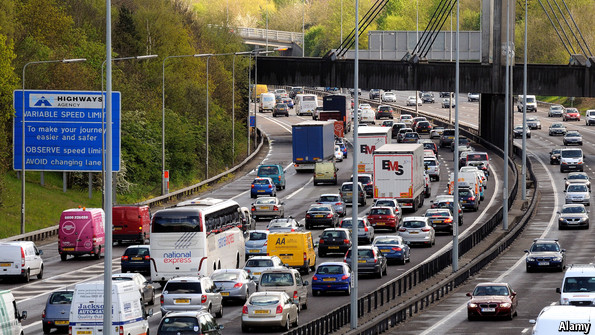
FEW things unite cultures more than the frustration of sitting in a line of stationary traffic, with no discernible reason for the blockage and no end in sight. From London to Los Angeles, Berlin to Bangalore, seething anger at standstills is a common emotion felt by all drivers. The causes of traffic jams are well understood (accidents; poor infrastructure; peak hour traffic; and variable traffic speeds on congested roads). But what is the cost of all this waiting around? The Centre for Economics and Business Research, a London-based consultancy, and INRIX, a traffic-data firm, have estimated the impact of such delays on the British, French, German and American economies. To do so they measured three costs: how idling in traffic reduces productivity of the labour force; how inflated transport costs push up the prices of goods; and the carbon equivalent cost of the fumes that exhausts splutter out. In 2013 the expenses from congestion totalled $200 billion (0.8% of GDP) across the four countries. As roadbuilding fails to keep up with the increasing numbers of cars on the road, that figure is expected to rise to nearly $300 billion by 2030. Two-thirds of the costs incurred are the result of wasted fuel and time that could be better spent elsewhere, and the remainder from increased business expenses. But these numbers mask huge variation within countries. In America the average cost of congestion to a car-owning household is estimated to be $1,700 a year, in France it is $2,500. Traffic is so bad in Los Angeles that each resident loses around $6,000 a year twiddling their thumbs in traffic—at a total cost of $23 billion, the costs are estimated to exceed that of Britain. But these costs do not take account of the price of carbon dioxide emissions. In total, over 15,000 kilotons of needless CO? fumes were expelled last year—it would cost an additional $350m to offset this carbon at current market prices. In choked-up Los Angeles $50m alone would have to be set-aside. Solving congestion is not easy. Building more roads or widening pre-existing ones can encourage more cars on to the roads, says Dominic Jordan, INRIX’s chief data scientist. Indeed, investment, employment growth and buoyant GDP are all contributors to increased traffic and associated costs: when people feel richer, they splurge on cars and petrol. Smart road networks that charge road users for travelling at busy periods or that nudge drivers through electronic signs to drive at a more uniform speed could help. More electric cars will bring down carbon emissions, while driverless ones could one day consign traffic jams to history. But until then drivers will remain stuck in second gear. — Source: The Economist

